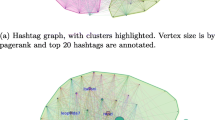Abstract
This paper focuses on the role of social relations within social media in the formation of public opinion. We propose to combine the detection of the users’ stance towards BREXIT, carried out by content analysis of Twitter messages, and the exploration of their social relations, by relying on social network analysis. The analysis of a novel Twitter corpus on the BREXIT debate, developed for our purposes, shows that like-minded individuals (sharing the same opinion towards the specific issue) are likely belonging to the same social network community. Moreover, opinion driven homophily is exhibited among neighbours. Interestingly, users’ stance shows diachronic evolution.
Access this chapter
Tax calculation will be finalised at checkout
Purchases are for personal use only
Similar content being viewed by others
Notes
- 1.
- 2.
Inter-Annotator Agreement: 65.48. The corpus is available for research purposes.
- 3.
Some users set privacy in order to hide profile information, while others shut down their profile after the referendum.
- 4.
References
Blondel, V.D., Guillaume, J.L., Lambiotte, R., Lefebvre, E.: Fast unfolding of communities in large networks. J. Stat. Mech. Theory Exp. (2008). 10
Deitrick, W., Hu, W.: Mutually enhancing community detection and sentiment analysis on Twitter networks. J. Data Anal. Inf. Process. 1, 19–29 (2013)
Gelman, A., King, G.: Why are American presidential election campaign polls so variable when votes are so predictable? Br. J. Polit. Sci. 23(04), 409–451 (1993)
Howard, P.N., Kollanyi, B.: Bots, #strongerin, and #brexit: computational propaganda during the uk-eu referendum. ArXiv e-prints (2016)
Lai, M., Hernández Farías, D.I., Patti, V., Rosso, P.: Friends and enemies of clinton and trump: using context for detecting stance in political tweets. In: Proceedings of the 15th Mexican International Conference on Artificial Intelligence. LNCS (2016)
McPherson, M., Smith-Lovin, L., Cook, J.M.: Birds of a feather: homophily in social networks. In: Annual Review of Sociology, pp. 415–444 (2001)
Mohammad, S., Kiritchenko, S., Sobhani, P., Zhu, X., Cherry, C.: Semeval-2016 task 6: detecting stance in tweets. In: Proceedings of the 10th International Workshop on Semantic Evaluation (SemEval-2016), pp. 31–41. ACL, San Diego (2016)
Pang, B., Lee, L.: Opinion mining and sentiment analysis. Found. Trends Inf. Retr. 2(1–2), 1–135 (2008)
Xu, K., Li, J., Liao, S.S.: Sentiment community detection in social networks. In: Proceedings of the 2011 iConference, iConference 2011, pp. 804–805. ACM, New York (2011)
Acknowledgments
The work of the last author has been partially funded by the Spanish Ministry of Economy, Industry and Competitiveness (MINECO) under the research project SomEMBED TIN2015-71147-C2-1-P and by the Generalitat Valenciana under the grant ALMAMATER (PrometeoII/2014/030).
Author information
Authors and Affiliations
Corresponding author
Editor information
Editors and Affiliations
Rights and permissions
Copyright information
© 2017 Springer International Publishing AG
About this paper
Cite this paper
Lai, M., Tambuscio, M., Patti, V., Ruffo, G., Rosso, P. (2017). Extracting Graph Topological Information and Users’ Opinion. In: Jones, G., et al. Experimental IR Meets Multilinguality, Multimodality, and Interaction. CLEF 2017. Lecture Notes in Computer Science(), vol 10456. Springer, Cham. https://doi.org/10.1007/978-3-319-65813-1_10
Download citation
DOI: https://doi.org/10.1007/978-3-319-65813-1_10
Published:
Publisher Name: Springer, Cham
Print ISBN: 978-3-319-65812-4
Online ISBN: 978-3-319-65813-1
eBook Packages: Computer ScienceComputer Science (R0)




